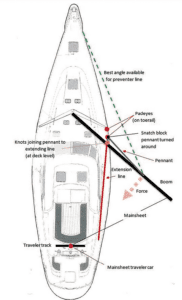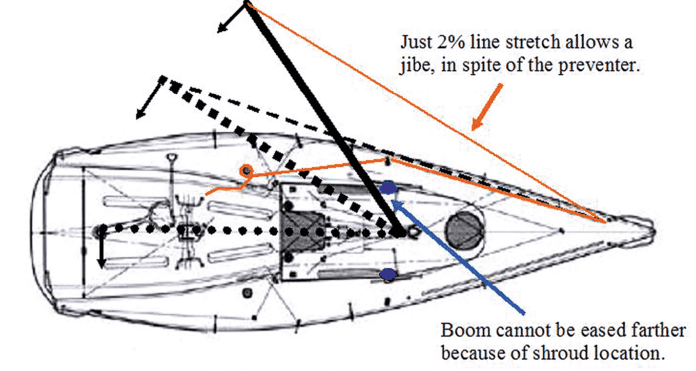We are vehemently against using a boom brake to prevent a jibe. Even using them to control a jibe introduces problems, requiring that we turn so far to leeward that wind gets on the other side of the main, well upwind of our true course on the next tack.
A more reliable way to control a jibe is to center the traveler and quickly sheet in the main while maintaining close attention to the helm. When it is nearly centered, the wind will catch the other side and the sail will come across. In strong winds you will want to let the sheet run out fast (wear gloves and put it on a winch), to prevent rounding up. Singlehanders should jibe the main first and then the jib—if needed.
Multihulls typically have enough directional stability that you can fully jibe the head sails before fully releasing the main. In fact, when sailing very deep, we have often jibed the main on a big cat by setting a course dead down wind and then cranking the traveler to the other side. The sail will jibe in the middle of the process. We then jibe the headsail and steer to the new course. This procedure can be helpful when singlehanding and using an autopilot. As a result, a brake is seldom fitted to multihulls.

CASE STUDIES
Recently, there have been a few widely publicized fatal accidents involving crash jibes and failed gear on boats with experienced crew. In all of these cases, it appears the load paths were not properly understood, too much faith was put in hardware or high-tensile materials, and poor seamanship was partially at fault.
1. Most recently, a German cruising couple was killed while they were on passage in the North Atlantic in their 66-foot CNB 66. PS will be doing a report related to this incident. Past contributor John Harries did an analysis of some actions that could have prevented that tragedy in his blog (www.morganscloud.com/2022/08/22/lessons-from-a-tragedy-at-sea/).
2. A failed preventer during a crash jibe led to the death of two sailors aboard the Ron Holland designed 66-foot sloop Platino in 2016. Among the contributing factors was the narrow angle of the preventer, which was not rigged to the boom end. Practical Sailor reported on the problems with this arrangement in 2017 (see “The Best Prevention is a Preventer,” PS July 2017), and New Zealand officials produced a detailed report (www.maritimenz.govt.nz/content/commercial/safety/accidents-reporting/accident-reports/documents/Platino-mnz-accident-report-2016.pdf).
3. Practical Sailor reported on a splice failure that led to tragedy aboard CV21, a 70-foot Clipper 70 sloop participating in the Clipper Around the World Race in 2015 (see “Splice Failure Linked to Fatality,” PS December 2018) The United Kingdom’s Marine Accident Investigation Board published a complete analysis (https://assets.publishing.service.gov.uk/media/58ee0b5040f0b606e7000166/MAIBInvReport07_2017.pdf).






































Don Street has been advocating for end boom sheeting and gybe preventer tackles for decades. He illustrates them in most of his books and cruising guides, and now with new lightweight, super strong, zero stretch dyneema this gear is even more practical. Lots of boats have no end boom bails or fittings, but they should be installed and used – led forward to the stem head, then back to a winch. He sold his legenday 100+ year old yacht Iolaire and its new owner immediately took it out, crash gybed it, and sank it due to not using the end boom gybe prevention that Don had been preaching basically since WW2.